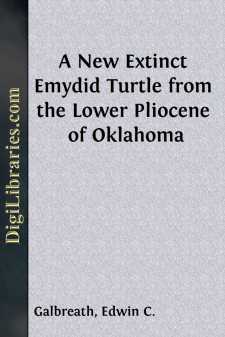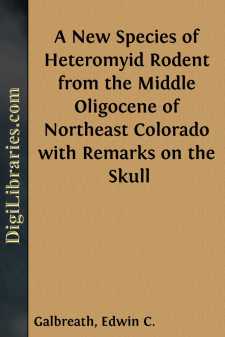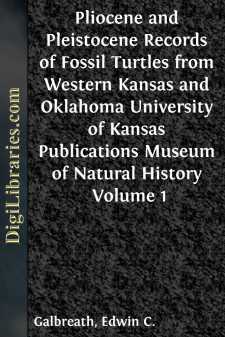Categories
- Antiques & Collectibles 13
- Architecture 36
- Art 48
- Bibles 22
- Biography & Autobiography 813
- Body, Mind & Spirit 142
- Business & Economics 28
- Children's Books 15
- Children's Fiction 12
- Computers 4
- Cooking 94
- Crafts & Hobbies 4
- Drama 346
- Education 46
- Family & Relationships 57
- Fiction 11828
- Games 19
- Gardening 17
- Health & Fitness 34
- History 1377
- House & Home 1
- Humor 147
- Juvenile Fiction 1873
- Juvenile Nonfiction 202
- Language Arts & Disciplines 88
- Law 16
- Literary Collections 686
- Literary Criticism 179
- Mathematics 13
- Medical 41
- Music 40
- Nature 179
- Non-Classifiable 1768
- Performing Arts 7
- Periodicals 1453
- Philosophy 64
- Photography 2
- Poetry 896
- Political Science 203
- Psychology 42
- Reference 154
- Religion 513
- Science 126
- Self-Help 84
- Social Science 81
- Sports & Recreation 34
- Study Aids 3
- Technology & Engineering 59
- Transportation 23
- Travel 463
- True Crime 29
A New Extinct Emydid Turtle from the Lower Pliocene of Oklahoma
Description:
Excerpt
In the summer of 1946 a party from the University of Kansas Museum of Natural History visited exposures of the Laverne formation in Beaver County, Oklahoma, at the invitation of Dr. Stuart Schoff of the United States Geological Survey. When examining the marl beds an Emydid turtle was discovered which appears to be an unnamed species of the genus Chrysemys. A description of the new species follows.
Chrysemys limnodytes, new species
Holotype.âUniversity of Kansas Museum of Natural History No. 7676, vertebrate paleontological collection, a turtle consisting of a fragmental anterior portion of a carapace, left part of the plastron, and several marginals collected by the 1946 paleontological field party of the University of Kansas Museum of Natural History.
Geological Age and locality.âMarl beds of the Laverne formation, early Pliocene age, in SW 1/4 Sec. 15, T. 4 N., R. 25 ECM, Beaver County, Oklahoma. The specimen was removed from the marl immediately below the fossil leaf zone (see Chaney and Elias, 1936; Frye and Hibbard, 1940).
Diagnosis.âSize large (see measurements) and differing from other species of Chrysemys in having: The anterior end of the carapace broadly concave, the posterolateral marginals not greatly flared, the posterior end of the plastron broadly indented, the carapace more sculptured and relatively wider.
Description of type.âThe specimen had been badly damaged before preservation, and had suffered further damage from exposure before discovery. The anterior and posterior lobes of the plastron had been folded over the bridge, forming a three-ply thickness of bone. Of the carapace, only the following parts are known: Fragment of the nuchal; right 1st, 7th, 8th, and 9th marginals, left 1st, 2d, 7th, 8th, 9th, and 11th marginals; costals 1-5 on the right side; costals 1-4 on the left side; and 1st, 2d, 3d, and 4th neurals. The left half of the plastron is relatively complete, lacking only the epiplastron and entoplastron. The left 7th, 8th, and 9th marginals are joined to the plastron at the inguinal buttress, and the right 7th, 8th, and 9th marginals are attached to the fifth costal. The carapace has smooth contours with no keel present, but on the lower half of the costals there are seven or eight ridges, and the remaining surface of the costals and neurals are rugose. The marginals lack ridges, and the posterolateral marginals are not serrated. The anterior end of the carapace has a broad shallow notch. The first neural is rounded, and the 2d, 3d, and 4th are hexagonal, with the broad ends forward. Anterior margins of the 2d and 3d neurals are concave, and the anterior margin of the 4th neural is straight.
The sulci bounding the scutes are moderately impressed. The width of the first vertebral scute, anteriorly and posteriorly, is less than the width of the second vertebral scute. The costal scutes join the marginal scutes on the marginal plates.
The plastron, broadly indented at the posterior end, does not have the posterior lobe flared laterally as it is in Recent species of Chrysemys, and lacks any pronounced notch at the femoro-anal suture. The humero-pectoral sulcus crosses the plastron behind the entoplastron in a straight line, and reaches the border anterior to the axillary notch. The pectoro-abdominal suture is anteriorly convex at the sides and concave at the midline.
A comparison of this carapace and plastron with a series of specimens of Recent Chrysemys picta and Pseudemys scripta of approximately the same size reveals characters indicated in the following chart:
Not serrated....



